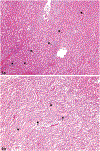Chronic progressive nephropathy in male F344 rats in 90-day toxicity studies: its occurrence and association with renal tubule tumors in subsequent 2-year bioassays
- PMID: 21422264
- PMCID: PMC12077603
- DOI: 10.1177/0192623310388432
Chronic progressive nephropathy in male F344 rats in 90-day toxicity studies: its occurrence and association with renal tubule tumors in subsequent 2-year bioassays
Abstract
The occurrence and severity of spontaneous chronic progressive nephropathy (CPN) in control male F344 rats as well as the frequency of treatment-related CPN exacerbation were histopathologically reevaluated. A series of 43 National Toxicology Program (NTP) 90-day toxicity studies comparing the influence of NIH-07 or NTP-2000 diets was examined. Relationships between the histopathologic findings at 90 days and renal tubule proliferative lesions recorded in subsequent 2-year bioassays for 24 chemicals were statistically analyzed. CPN lesions were observed in 100% of the control male rats regardless of diet, but CPN was more severe in control rats fed NIH-07. Approximately one-third of the 90-day studies demonstrated a treatment-related exacerbation of CPN severity, which was independent of diet. For chemicals that proceeded to 2-year bioassays, all studies with a statistically significant increase in renal tubule tumors (RTT) at 2 years had treatment-related exacerbation of CPN in the 90-day and 2-year studies. These findings indicate that CPN occurs ubiquitously in young male F344 rats and that treatment-related exacerbation of CPN in 90-day studies is a relatively common occurrence, having the potential to be predictive of an increased incidence of RTT in subsequent 2-year bioassays.
Figures

References
-
- Anver MR, Cohen BJ, Lattuada CP, and Foster CJ (1982). Age associated lesions in barrier-reared male Sprague-Dawley rats: A comparison between Hap:(SD) and Crl:COBS[R]CD[R]SD stocks. Exp Aging Res 8, 3–24. - PubMed
-
- Bailer AJ, and Portier CJ (1988). Effects of treatment-induced mortality and tumor-induced mortality on tests for carcinogenicity in small samples. Biometrics 44, 417–31. - PubMed
-
- Boobis AR, Cohen SM, Doerrer NG, Galloway SM, Haley PJ, Hard GC, Hess FG, et al. (2009). A data-based assessment of alternative strategies for identification of potential human cancer hazards. Toxicol Pathol 37, 714–32. - PubMed
Publication types
MeSH terms
Substances
Grants and funding
LinkOut - more resources
Full Text Sources
Medical

